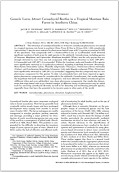| Journal Article |
 |
|
| Article Title | Generic Lures Attract Cerambycid Beetles in a Tropical Montane Rain Forest in Southern China | | Author | Jacob D. Wickham, Rhett Daniel Harrison, Wen Lu, Zhenpeng Guo, Jocelyn G. Millar, Lawrence M. Hanks and Yi Chen | | Year | 2014 | | Journal Title | Journal of Economic Entomology | | Institution | Entomological Society of America | | Volume | 107 | | Issue | 1 | | Pages | 259-267 | | Call Number | JA0544-14 | | Keywords | Cerambycidae, pheromone, attractant, longhorned beetle |
|
| Abstract: |
| The attraction of cerambycid beetles to 10 known cerambycid pheromones was tested
in a tropical montane rain forest in southern China. From 28 May to 25 June 2010, 1,526 cerambycids
representing 71 species were captured in pheromone-baited traps, with 14 species accounting for 92%
of the specimens. Test compounds with a 3-hydroxyalkan-2-one or 2,3-alkanediol motif attracted
signiÞcant numbers of both sexes for eight species in the subfamily Cerambycinae, including species
of Demonax, Rhaphuma, and Xylotrechus. Rhaphuma horsfieldi (White) was the only species that was
strongly attracted to more than one test compound, with signiÞcant attraction to both (2R*,3R*)-
2,3-hexanediol and (2R*,3R*)-2,3-octanediol. Within the Lamiinae, males and females of Þve species
were signiÞcantly attracted to 2-(undecyloxy)ethanol, including Acalolepta formosana (Breuning), Monochamus bimaculatus Gahan, Pharsalia subgemmata (Thomson), Pseudomacrochenus antennatus (Gahan), and Xenohammus bimaculatus Schwarzer. Only male Megopis costipennis White (Prioninae)
were signiÞcantly attracted to (2R*,3S*)-2,3-octanediol, suggesting that this compound may be a sex
pheromone component for this species. To date, 2,3-octanediols have only been reported as aggregation
pheromone components for cerambycids in the subfamily Cerambycinae. Our results support
the hypothesis that both closely related (congeners) and more distantly related cerambycid species
(different tribes and even subfamilies) may share pheromone components. Our results also demonstrate
that traps baited with even a limited number of different classes of pheromones may be useful
tools for surveying cerambycid diversity, as well as for detecting and monitoring particular species,
especially those that have the potential to be invasive pests in other parts of the world. |
|